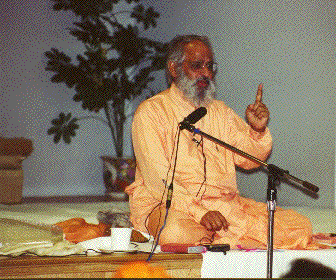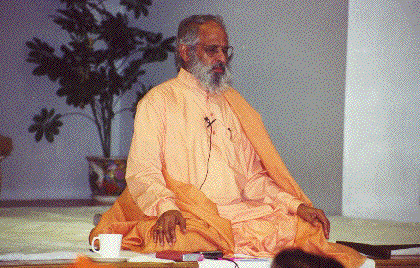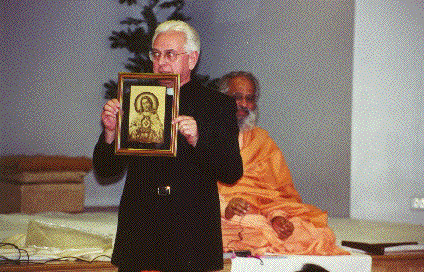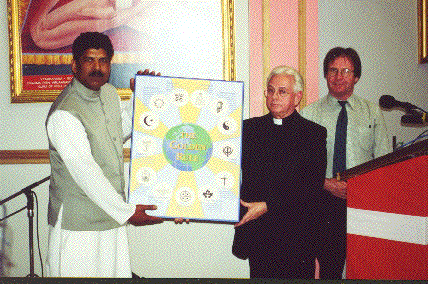By Consul B. John Zavrel

Swami Veda speaking in the Arya Samaj Vedic Centre in Toronto.
By Consul B. John Zavrel

Swami Veda speaking in the Arya Samaj Vedic Centre in Toronto.
'There are forces beside human ones that are the fountainhead from which all urge to worship proceeds, and which further teach all 'chosen peoples' in all centuries and all nations even the way to worship. It is their presence that is the unifying stream among all our religions. It is because of this common source in the Divine Forces that so many symbols, forms, rituals, and verbal or art forms are shared among religions', said Swami Veda Bharati, a prominent spiritual teacher and guide to many in Europe, Asia and America.
Swami Veda, one of the most respected swamis (monks) in all of India, was the keynote speaker in an Interfaith program at the Arya Samaj Vedic Center in Toronto on May 6, 2001. His talk was preceeded by brief prayers by representatives of nine different faith groups. After the prayers, Swami Veda presented a gold-plated framed relief of Jesus to Father Raymond O'Toole on the behalf of the Scarborough Mission.
Addressing the audience, Swami Veda, the sage in orange robes, sitting steady like a rock in a traditional yogic posture, asks: 'In which inter-religious council of the world was it agreed that Hindus, Buddhists, and Christians of all denominations would join the hands before the heart in worship? Can you tell me?'
'Who decreed that people of all faiths should kneel or bow in one form or another to the presence of Divinity?
When was it agreed that prayers should be counted on rosary, mala, or tasbeeh by the Christian, Hindu-Buddhist-Taoist, and the Muslim?
Who determined that sacred and holy water, whether from Jordan, Ganga, or Zamzam, should be an important component of religious observance for the Christian, Hindu, Buddhist, Taoist, and the Muslim?
Which master architect planned all edifices for worship to point upwards into the sky?
When was the agreement signed that incense be burned in sacred places of the Hindu, Buddhist, American Indian, Muslim and Catholic?
How is it that ringing a bell has been part of a ritual among so many different forms of worship in different religions?
Who determined that meatless days be observed by the adherents of all religions?
Is it strange that what the Asian religions (Hinduism and Buddhism) refer to as dashansha (tenth part of one's income to be donated) is equally considered a bounden duty as tithing in Western religions?
Who determined that people of all faiths should say grace before meals?
Who taught to all that an immersion in a holy river would constitute a spiritual rebirth?
Who developed the idea that the followers of each religion should have a sacred book, in written or oral form?
Who instituted the tradition of song as an offering to Divinity in all religions?
How is it that as part of 'a floating mass of wisdom' the people of all religions tell parables and stories that parallel each other, one claiming it to be Hindu, another calling it Sufi, or Buddhist, or Christian?
How is it that we find some almost identical passages in Popul Vuh, the Bible, the Koran, Mahabharata, Dhammapada, Avesta, and the Upanishads?
How did the Druids, the Brahmins, and the followers of Pythagoras all develop a faith in reincarnation, in lands so distant from each other?
With this, Swami Veda comes to the point: 'So, what gives the right to the followers of some religions to condemn as 'primitive' (whatever that means!) such uniformly agreed ways of wisdom? Why not simply acknowledge that the unifying streams among religions have always flowed in freedom, irrespective of repression, and that all we need to do is to look at the power of these streams to chart the course for the flow of our own river of history into the future.'
Although divisive political forces bear much of the responsibility for separation among religions, it must be also said that in the course of history there have been many kings who searched for the meaning of truth in all religions, or in one way or another tried to reconcile the concept of non-violence with their statecraft. Akhenaton in the thirteen century B.C., because of his religious conviction, chose not to resort to armed force. The emperor Khusro of Iran, a follower of Zarathushtra, liberated 40,000 Jews from Babylonian captivity and helped them to rebuild the Temple of Solomon. He also encouraged the Egyptian priests to revive diligently their own forms of worship under his patronage. His son Dara followed in his footsteps. Ashoka in the third century B.C. disbanded his armies and ruled an entire empire by the power of virtue (dharma). He also provided patronage to the followers of different religions while he himself remained and adherent of Buddhism.
The coming together of religions is neither a novel idea nor something difficult to obtain. In our modern times guides like Gandhi, Martin Luther King, and Bishop Desmond Tutu were all apostles of non-violence, religiously inspired. Often the ascetic inspired by spirituality conquers the emperor by strength of his faith.
It is well known that in pluralistic societies the common people, being exposed to the experience of each other's belief system and practices, often manage to merge them. People begin sharing experiences and practices out of neighborly courtesy. This they manage to do without infringing their own basic belief systems. They accommodate the divergent only to the extent that no major infringement of their own faith might occur. The songs sung in rituals may be adapted from one religion to fill a need in another.
Often an accommodation is found to insert the traditions and forms of an older religion into the new religion of a conqueror, or of one who evangelizes a local population. An example is the continuity of the Christmas tree tradition in Christianity, even though Odin and Thor have been abandoned and Jesus has replaced them. The two divergent streams are unified and one cannot say where one ends and the other begins.
And Swami Veda continues: 'Often the religion changes but the sacred is retained. The shrines of indigenous people taken over by theologically more sophisticated religions continue to be sacred. Among the more tolerant lands even the icons are not replaced. An example is the Jagannatha shrine at Puri in Orissa. Elsewhere, the site of the religion of the conquered or the converted may be altered into the church, mosque, or temple of the conqueror or the evangelist, but the site itself remains sacred, reserved for worship, now in a new form. The Sun temple of the Incas in Cusco is an example.'
One of the major experiments in flowing with the unifying stream in religions has been going on in India for many thousands of years. Here Hindu, Buddhist, and Jaina have constantly interacted. It is said that Buddhism disappeared from India. Not so. Its tenets were absorbed into the Hindu view of life and practices, just as the Hindu forms of the deity were included in Mahayana Buddhism in mainland India, its maritime regions, and in Tibet. In India, the Jainas and the Zarathushtrians both study the Bhagavad-gita with the same diligence as the Hindus. The Jainas offer prayers to the Hindu forms. The shrine in Bodh-gaya, where the Buddha attained enlightenment, is sacred to both Hinduism and Buddhism, for different reasons, and the people of both religions have worshipped there together for a thousand years, notwithstanding the sad situation that political forces, ignorant of the people's genius, today are causing a division.
'The realization of a Supreme Reality as One Self, atman, ever remaining that one indivisible Self and yet taking multifarious forms, could be the basis of a universal doctrine that would unite all religions in a view of "one in many and many in one", accepting the variety of manifestations revealed to different people at different times', says Swami Veda.
He explains: 'Here we are not talking of tolerance, co-existence and such, but a realization on the parts of all to recognize the many ways of God and honor, venerate and revere them all. Those seeking a way to find mutual accommodation among religions need to study in depth both the Vedic vishu-rupa philosophy as well as the anekanta doctrine and make it a part of personal realization. This is not merely a tolerance for another forced out of fear of violence and destruction, not a mere response to difficult situations created by humanity's ignorance. This is the credo that millions, nay billions, uphold. All they need on this path is encouragement granted to them by their guides. It is not to 'give them freedom', for that is not anyone's to grant, but it is to recognize and respect freedom in law and in love, and it is to educate future generations into remaining true to these perennial truths.
And Swami Veda concludes: 'Such an education will not be possible, nor will there develop the state of mind that leads to choice of non-violent inclinations, unless the contemplative heritage of all religions and spiritual traditions is revived. The methods of contemplation to retrain the mind, the ways of meditation, also seem to be divergent, but there are certain procedures common to all systems of meditation. The advantage of this core component of divergent meditation systems is that it can be practiced within the context of all religious traditions without violating any of their tenets. Its practice would strengthen the faith of each through the purification and clarification of the spiritual mind.
'I'm hoping for a seven-day retreat of the representatives of the major religions: A SILENT RETREAT. Total silence for seven days,' are the parting words of Swami Veda, a disciple of Swami Rama of the Himalayas.

Swami Veda in meditation before addressing the audience in Toronto.
To show the audience the path to interior peace, Swami Veda, a master meditator, lead them through a brief, 5-minute guided meditation:
Let us bring our awareness to our being.
Let us know ourselves to be the Temple of God.
Let the seat of our thought, the forehead, relax.
Observe the gift of Divinity granted to us in the form of our very life, manifest in each breath.
Feel the flow and the touch of the breath in the nostrils.
This is a gift of grace being granted to us every moment.
Breathe gently, slowly, moothly;
without a jerk, without a pause between the breaths.
Now, bring to mind your preferred Name for divinity according ot your own religion and language.
Exhaling, think that one Name.
Inhaling, think that one Name.
No break in the feel of the flow of breath.
No break between the contemplation of the Name and the Name.
Observe how the mind, breath, and the Name flow together as a single stream.
The entire mind has become a quiet stream flowing towards the infinite Divinity within.
Continue to obseve the flow; gently open your eyes.
May this peace prevailing in our minds radiate as a blessing and pervade the consciousness of all beings in the universe.
Om Shantih, Shantih, Shantih.
Peace. Peace. Peace.

Father Raymond O'Toole receives a gold-plated relief of Jesus from Swami Veda.

Father Ramond O'Toole presents a painting to the Arya Samaj Vedic Center in Toronto illustrating the 'Golden Rule' with the symbols of 13 major religious faiths.